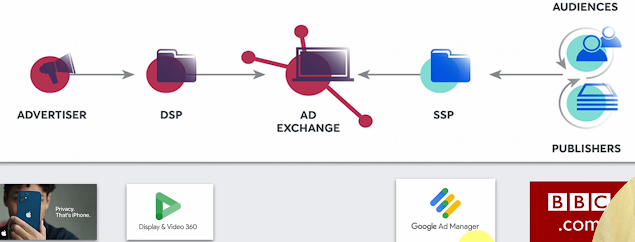programmatic advertising for beginners
here's a step-by-step process for programmatic advertising, specifically for showing Apple's 13pro ad on bbc.com.
Step 1: Setting up the campaign in DV360:(DSP)
The advertiser (Apple) will create a campaign in the demand-side platform (DSP) DV360.
In DV360, the advertiser will set up targeting options such as demographics, interests, and behaviors to reach the desired audience for the 13pro ad.
The advertiser will also set a budget for the campaign and choose to advertise on both mobile and desktop devices.
Step 2: Using Ad Exchange as an application:
Once the campaign is set up in DV360, the advertiser will use Ad Exchange as an application to connect with multiple supply-side platforms (SSP) and publishers.
Ad Exchange allows the advertiser to access more inventory and have more options for the campaign.
Step 3: Using Google Ad Manager as a SSP:
The advertiser will then use Google Ad Manager as the SSP to connect with specific publishers, in this case, bbc.com.
Google Ad Manager allows the advertiser to access more inventory and also create and manage line items, creatives, and ad units.
Step 4: Tracking and Optimization:
The advertiser will then track and optimize the performance of the campaign using tools such as Google Analytics.
The advertiser will use the data and insights gathered from Google Analytics to make adjustments to the targeting options, ad copy, and images to improve the performance of the campaign.
The advertiser will also review the campaign's performance regularly and adjust the budget as needed to ensure that the campaign is reaching the desired audience in the most cost-effective way.
Note: "Please note that the step-by-step process for programmatic advertising provided above is an example and may not be the exact process followed by all advertisers. Each advertiser may have their own unique process and may use different tools and platforms. The purpose of this guide is to give an idea of the general steps involved in programmatic advertising and how different tools and platforms can be used to create and manage a campaign. It is not intended as a substitute for professional advice or guidance."
Note: "Please note that the step-by-step process for programmatic advertising provided above is an example and may not be the exact process followed by all advertisers. Each advertiser may have their own unique process and may use different tools and platforms. The purpose of this guide is to give an idea of the general steps involved in programmatic advertising and how different tools and platforms can be used to create and manage a campaign. It is not intended as a substitute for professional advice or guidance."

Comments
Post a Comment